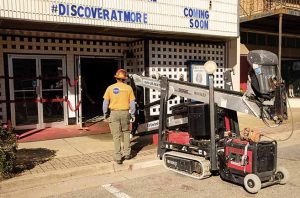$3M restoration of historic theater finally under way

By DON FLETCHER
News Staff Writer
In order to save the Strand Theatre, it is necessary to destroy the Strand Theatre. Or at least a large portion of it.
To restore the Strand to its former architectural glory, crews from Daphne-based Virginia Wrecking Co. began last week the process of knocking down or ripping out the back wall, seats, ceilings and all other changes made to the original movie house over the course of its life.
The theater was built in 1924, then rebuilt in 1936. A scissors lift was brought in this week to start taking down the silver screen, which last flickered to life on November 9, 2013.
Bub Gideons, president of Pride of Atmore Committee, said he was happy to see the onset of a $3 million renovation and restoration project designed to create a shiny replica of the Strand, circa 1936. The project also includes upgrades and repairs to the former Atmore Hardware building, which shares an interior wall with the Strand.
“This is long awaited,” Gideons said. “We’ve been able to finally raise the money needed to make that step forward. I apologize to the public because it has looked like nothing was being done. But we’ve been working toward this the past few years. Finally, people can see something that can make them feel that this is something good for Atmore.”
A group of 10 POA members took a brief tour January 27 to view the initial demolition and discuss the plan to upgrade, renovate and repair the Strand’s facade, mechanical systems, lobby, roof, marquee, ceilings, concession area, theatre seating, projection room and acoustics.
POA member Cindy Colville said the project would move in stages, as reports must be filed with the Alabama Department of Environmental Management (ADEM) during each step of the demolition process.
“It should take them about two-and-a-half to three weeks,” Colville said. “But from the time they begin, they have to notify ADEM about hazardous materials removal. A lot of the things they did first, they did because they can’t do some things until after the ten-day period until they hear back from ADEM. It’s like a permit to go ahead and do some other things. We’re in that ten-day period; we hope to hear back from ADEM any day now.”
She further explained that the granting of historic tax credits hinges on making the theater look just like it did in its early heyday.
“Exploratory demolition is required for the historic tax credits,” she said. “All this stuff that was added in the 1970s and 1980s has to be removed so we can take a picture of what the original façade and fixtures looked like, because that’s what it will be restored to. Not like it looks now, but more of the original look.”
Once the exploratory demolition is completed, there will be “a pause in all of this” until the primary contractor, Rolin Construction, gets the green light to proceed.
Dale Ash, also a member of the committee, pointed out that the floor now visible in the lobby is the one left after two others were torn out. She said she was excited that the project was under way and pointed out one other aspect that could make things even more exciting.
“If it just comes in under budget, that would be wonderful,” she said.
